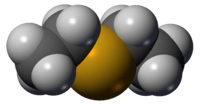Diethyl sulfide
| | |
 | |
| Names | |
|---|---|
| IUPAC name
1,1-Thiobisethane | |
| Other names
diethyl thioether, ethyl sulfide, thioethyl ether | |
| Identifiers | |
| 352-93-2 | |
| 3D model (Jmol) | Interactive image |
| ChEBI | CHEBI:27710 |
| ChEMBL | ChEMBL117181 |
| ChemSpider | 9233 |
| ECHA InfoCard | 100.005.934 |
| EC Number | 206-526-9 |
| KEGG | C14706 |
| PubChem | 6163 |
| RTECS number | LC7200000 |
| |
| |
| Properties | |
| C4H10S | |
| Molar mass | 90.19 |
| Appearance | Clear liquid |
| Density | 0.837 g/cm3 |
| Melting point | −103.8 °C (−154.8 °F; 169.3 K) |
| Boiling point | 92 °C (198 °F; 365 K) |
| insoluble | |
| Solubility in ethanol | fully miscible |
| Solubility in diethyl ether | fully miscible |
| Refractive index (nD) |
1.44233 |
| Hazards | |
| Main hazards | Skin and eye irritant. Highly flammable liquid and vapor |
| Safety data sheet | External MSDS |
| R-phrases | R11 R65 |
| S-phrases | (S2) S9 S16 S51 S62 |
| NFPA 704 | |
| Flash point | −10 °C (14 °F; 263 K) |
| Related compounds | |
| Related thioethers |
dimethyl sulfide |
| Except where otherwise noted, data are given for materials in their standard state (at 25 °C [77 °F], 100 kPa). | |
| | |
| Infobox references | |
Diethyl sulfide is a clear flammable chemical compound with a pungent garlic-like odor. It has the chemical formula C
4H
10S, though it can also be written (C
2H
5)
2S or Et
2S to make its chemical structure more clear. It is prepared by treating ethanol with concentrated sulfuric acid, partially neutralizing the new solution with sodium carbonate, then distilling the resulting sodium ethyl sulfate in a solution containing potassium sulfide.[1]
Diethyl sulfide is a by-product of the commercial production of ethanethiol, which is prepared by the reaction of ethylene with hydrogen sulfide over an alumina-based catalyst. The amount of diethyl sulfide produced can be controlled by varying the ratio of hydrogen sulfide to ethylene.
Occurrence
Diethyl sulfide has been found to be a constituent of the odor of durian fruit[2] and as a constituent found in volatiles from potatoes.[3]
Uses
Diethyl sulfide is used as a solvent for anhydrous minerals and in plating baths for gold and silver.[1]
References
- 1 2 Merck index of Chemicals and Drugs, 9th ed., monograph 3801
- ↑ Baldry, Jane; J. Dougan; G. E. Howard (1972). "Volatile Flavouring Constituents of Durian". Phytochemistry. 11: 2081–2084. doi:10.1016/s0031-9422(00)90176-6.
- ↑ Gumbmann, M. R.; H. K. Burr (1964). "Volatile Sulfur Compounds in Potatoes". Journal of Food and Agricultural Chemistry. 12: 404–408. doi:10.1021/jf60135a004.
